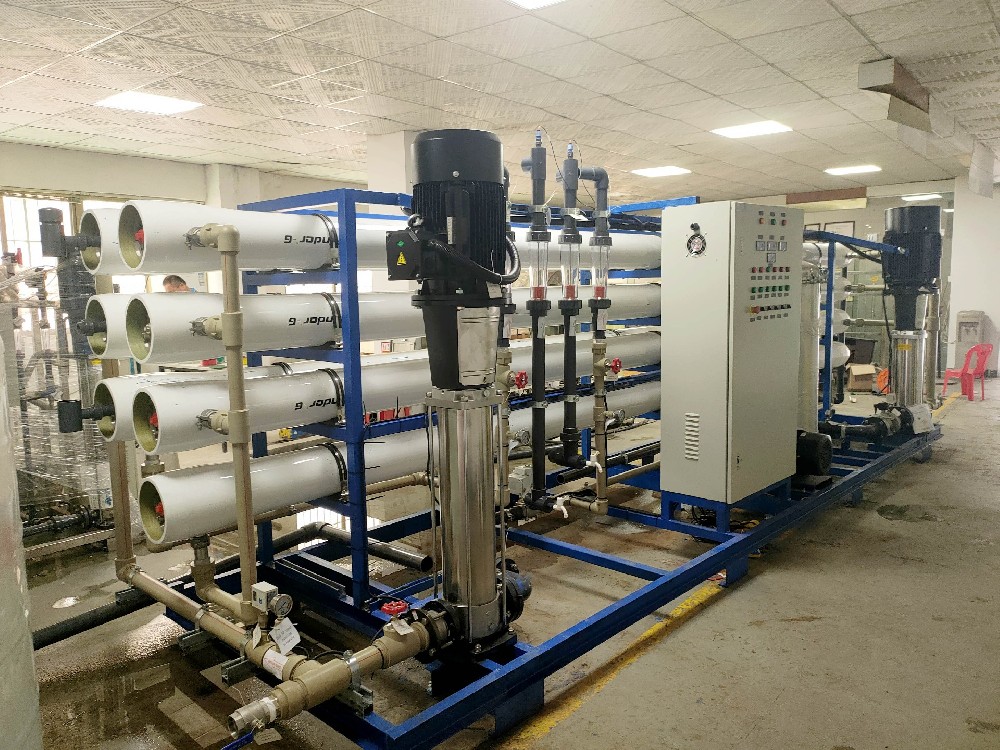
Wechat/Whatsapp:
+8613798883773

Wechat/Whatsapp:
+8613798883773
HYWATER Reverse Osmosis plant/system


Summary of membrane treatment plant There are many relevant performance indicators of membrane products, which mainly include three categories: separation and permeation performance, physical performance and chemical performance. quality), retention rate, desalination rate, recovery rate, maximum pore size, average pore size, pore size distribution, porosity, air tightness and integrity, etc.; membrane physical properties include: structural properties (appearance, membrane area, membrane thickness, membrane filaments) Inner and outer diameter), mechanical properties (tensile strength, burst strength, flexural strength, softness index, elongation at break), electrical properties (chargeability, Zeta potential), hydrophilicity (contact angle) and heat resistance (the highest The chemical properties of the membrane include: chemical stability (chemical compatibility), oxidation resistance (short-term residual chlorine tolerance limit, hydrogen peroxide tolerance limit), acid and alkali resistance (operation and cleaning pH range ) and pollution resistance. The membrane separation and permeation performance reflects the applicable scope of the filter membrane, and the physical and chemical properties reflect the use conditions of the filter membrane. Membrane separation and permeation performance is the most important technical index of membrane products. There are many related research and testing methods, and it is also the main technical content of existing membrane product standards. Except for structural performance, the relevant standards for membrane physical and chemical performance indicators are still blank. Standard Analysis of Membranes and Membrane Modules Membrane products are classified into microfiltration (MF) membrane, ultrafiltration (UF) membrane, nanofiltration (NF) membrane, reverse osmosis (RO) membrane and ion exchange membrane according to the membrane separation process; Membrane, roll membrane, hollow fiber membrane (column type, curtain type), tubular membrane, disc tube membrane, etc. General standards include "Membrane Separation Technical Terminology" (GB/T20103-2006) and "Model Naming of Membrane Modules and Devices" (GB/T20502-2006). Among them, the GB/T20103-2006 standard defines the common terms in the field of membrane separation, including electrodialysis, reverse osmosis, nanofiltration, ultrafiltration, microfiltration, gas separation membrane and ion exchange membrane, and carries out 221 terms in the field of membrane separation technology. Definition, applicable to membranes and membrane materials, membrane modules, liquid separation, gas separation and other membrane separation processes. The GB/T20502-2006 standard specifies the naming rules for membrane modules and device models, which are applicable to reverse osmosis, nanofiltration, ultrafiltration, microfiltration, gas separation membranes, electrodialysis and electrodeionization devices. The HY/T049-1999 standard specifies the test conditions and test methods for the salt removal rate and water flux of the hollow fiber reverse osmosis membrane, which is suitable for the test of the hollow fiber reverse osmosis membrane with tap water, brackish water and sea water. Before the test, the sample preparation should be carried out, and the film wire is bonded to the nylon tube or rubber stopper with epoxy resin, and then the cured film sample is loaded into the test tube and tested on the test device. The requirements for test tubes are not specified or specified in detail. The measurement of water flux is measured with a graduated cylinder and a stopwatch, and does not require constant temperature. The measured data is converted into the value at 25 ℃ by looking up the table. The HY/T107-2008 standard specifies the test methods for the six parameters of the roll reverse osmosis membrane element: desalination rate, recovery rate, water production, water flux, seal leakage point and air tightness. The desalination rate can be calculated by the sodium chloride concentration method or the conductivity method. At present, hollow fiber reverse osmosis membranes are rare, and almost all of them are rolled reverse osmosis membranes. However, there is a lack of standards for the performance and technical requirements of rolled reverse osmosis membrane elements. The nominal value of the quality inspection is carried out, and the evaluation scale is not uniform. This problem will be solved after the release and implementation of the marine industry standard "Rolled Polyamide Composite Reverse Osmosis Membrane Element" drafted by Times Wharton. There is one nanofiltration membrane standard, namely "Nanofiltration Membrane and Its Components" (HY/T113-2008). This standard specifies the classification and types, requirements, testing and inspection rules of nanofiltration membranes and their components. The technical requirements specify the water flux and removal rate of nanofiltration membranes for monovalent ions and divalent ions under standard conditions, and the salt removal rate can be measured by gravimetric method or conductivity method. Using 500mg/L NaCl as the test solution for monovalent ions, the removal rate should not be less than 30%; for divalent ions, using 2000mg/L MgSO4 as the test solution, the removal rate should not be less than 90%. Ultrafiltration membrane retention performance The retention performance of ultrafiltration membranes includes two indicators of molecular weight and retention rate, which are the most important separation performance indicators of ultrafiltration membranes. The retention rate refers to the ratio of specific solutes retained by the ultrafiltration membrane to the total specific solutes in the solution, and the molecular weight rejection refers to the minimum molecular weight when the retention rate of a specific solute by the membrane reaches more than 90%. They are surrogate parameters reflecting the pore size and distribution of the membrane, which determine the separation performance of ultrafiltration membranes. More inquiries related to Membrane treatment plant please contact: Mob& Wechat& WhatsApp: (+86)13544774483 Email: sales010@water-sy.com We will provide high-quality, all-round comprehensive professional services for project consulting, system design, manufacturing, installation and commissioning, personnel training, etc
